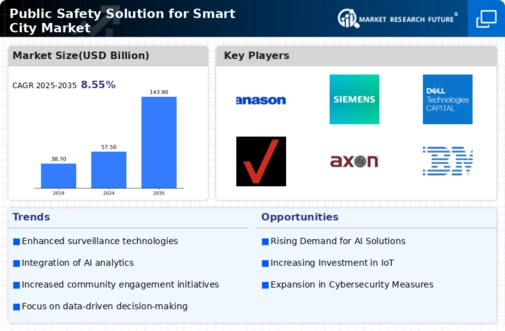Rising Crime Rates
The persistent rise in crime rates in urban areas necessitates the implementation of effective public safety solutions, thereby propelling the Global Public Safety Solution for Smart City Market Industry. Cities are increasingly adopting advanced surveillance systems, emergency response technologies, and community policing strategies to combat crime. For instance, Chicago has implemented a comprehensive public safety strategy that integrates technology with community engagement, resulting in a notable decrease in crime rates. This trend highlights the urgent need for cities to invest in safety solutions, as the market is expected to grow significantly, driven by the demand for effective crime prevention measures.
Increased Urbanization
The rapid pace of urbanization globally drives the demand for enhanced public safety solutions in smart cities. As urban populations grow, cities face challenges such as crime, traffic congestion, and emergency response times. The Global Public Safety Solution for Smart City Market Industry is expected to reach 57.5 USD Billion in 2024, reflecting the urgent need for integrated safety systems. Governments are investing in technologies like surveillance cameras, smart lighting, and emergency response systems to address these challenges. For instance, cities like Singapore and Barcelona have implemented smart city initiatives that leverage data analytics to improve public safety, showcasing the potential of these solutions.
Market Growth Projections
The Global Public Safety Solution for Smart City Market Industry is projected to experience substantial growth over the coming years. With a market value of 57.5 USD Billion in 2024, it is anticipated to reach 143.9 USD Billion by 2035, reflecting a compound annual growth rate of 8.7% from 2025 to 2035. This growth is driven by various factors, including technological advancements, increased urbanization, and rising crime rates. As cities continue to evolve and embrace smart technologies, the demand for integrated public safety solutions is likely to expand, presenting opportunities for innovation and investment in the sector.
Technological Advancements
Technological innovations play a crucial role in shaping the Global Public Safety Solution for Smart City Market Industry. Advancements in artificial intelligence, machine learning, and IoT enable cities to deploy sophisticated safety solutions. These technologies facilitate real-time data analysis, predictive policing, and automated emergency response systems. For example, cities like Los Angeles utilize AI-driven analytics to optimize police patrol routes, thereby enhancing response times. The integration of these technologies is projected to contribute to a compound annual growth rate of 8.7% from 2025 to 2035, indicating a robust market trajectory driven by continuous innovation and the need for smarter safety solutions.
Government Initiatives and Funding
Government initiatives and funding are pivotal in advancing the Global Public Safety Solution for Smart City Market Industry. Many governments recognize the importance of public safety in urban planning and are allocating substantial budgets to enhance safety infrastructure. For instance, the U.S. Department of Homeland Security has launched various programs aimed at improving urban safety through technology. Such initiatives not only provide financial support but also encourage public-private partnerships, fostering innovation in safety solutions. As cities increasingly prioritize safety, the market is likely to expand, with projections indicating a growth to 143.9 USD Billion by 2035, underscoring the significance of government involvement.
Public Awareness and Demand for Safety
Growing public awareness regarding safety issues is influencing the Global Public Safety Solution for Smart City Market Industry. Citizens are increasingly demanding safer urban environments, prompting governments and city planners to prioritize public safety in their agendas. This heightened awareness leads to greater investment in safety technologies, such as smart surveillance systems and emergency communication platforms. For example, cities like Amsterdam have engaged citizens in safety initiatives, fostering a collaborative approach to urban safety. As public demand for safety solutions escalates, the market is poised for growth, reflecting the evolving expectations of urban residents.













